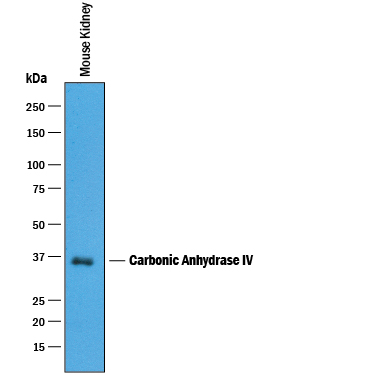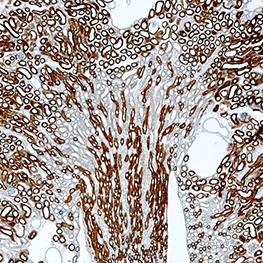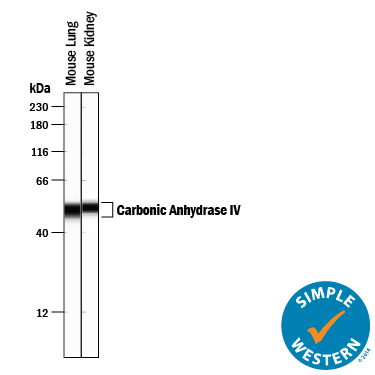Mouse Carbonic Anhydrase IV/CA4 Antibody Summary
Glu18-Ser277
Accession # Q64444
Applications
Please Note: Optimal dilutions should be determined by each laboratory for each application. General Protocols are available in the Technical Information section on our website.
Scientific Data
 View Larger
View Larger
Detection of Mouse Carbonic Anhydrase IV/CA4 by Western Blot. Western blot shows lysates of mouse kidney tissue. PVDF membrane was probed with 0.25 µg/mL of Goat Anti-Mouse Carbonic Anhydrase IV/CA4 Antigen Affinity-purified Polyclonal Antibody (Catalog # AF2414) followed by HRP-conjugated Anti-Goat IgG Secondary Antibody (Catalog # HAF019). A specific band was detected for Carbonic Anhydrase IV/CA4 at approximately 35 kDa (as indicated). This experiment was conducted under reducing conditions and using Immunoblot Buffer Group 1.
 View Larger
View Larger
Carbonic Anhydrase IV/CA4 in Mouse Kidney. Carbonic Anhydrase IV/CA4 was detected in perfusion fixed frozen sections of mouse kidney using Goat Anti-Mouse Carbonic Anhydrase IV/CA4 Antigen Affinity-purified Polyclonal Antibody (Catalog # AF2414) at 3 µg/mL overnight at 4 °C. Tissue was stained using the Anti-Goat HRP-DAB Cell & Tissue Staining Kit (brown; Catalog # CTS008) and counterstained with hematoxylin (blue). Specific staining was localized to cytoplasm in epithelial cells. View our protocol for Chromogenic IHC Staining of Frozen Tissue Sections.
 View Larger
View Larger
Detection of Mouse Carbonic Anhydrase IV/CA4 by Simple WesternTM. Simple Western lane view shows lysates of mouse lung tissue and mouse kidney tissue, loaded at 0.2 mg/mL. A specific band was detected for Carbonic Anhydrase IV/CA4 at approximately 51-52 kDa (as indicated) using 12.5 µg/mL of Goat Anti-Mouse Carbonic Anhydrase IV/CA4 Antigen Affinity-purified Polyclonal Antibody (Catalog # AF2414) followed by 1:50 dilution of HRP-conjugated Anti-Goat IgG Secondary Antibody (Catalog # HAF109). This experiment was conducted under reducing conditions and using the 12-230 kDa separation system.
Reconstitution Calculator
Preparation and Storage
- 12 months from date of receipt, -20 to -70 °C as supplied.
- 1 month, 2 to 8 °C under sterile conditions after reconstitution.
- 6 months, -20 to -70 °C under sterile conditions after reconstitution.
Background: Carbonic Anhydrase IV/CA4
Carbonic anhydrase (CA) catalyzes the reversible reaction of CO2 + H2O = HCO3- + H+, which is fundamental to many processes such as respiration, renal tubular acidification and bone resorption (1). Topics in a CA meeting (6th International Conference on the CAs, June 20‑25, 2003, Slovakia) ranged from use of CAs as markers for tumor and hypoxia in clinic, as nutritional supplement in milk, and as a tool for CO2 removal and mosquito control in industry. The deduced amino acid sequence of mouse CA4 consists of a signal peptide (residues 1‑17), an ectodomain (residues 18‑277) and a pro peptide (residues 278‑305), which is removed in the mature form (2). The native enzyme is attached to the membrane by a GPI‑anchor. Recombinant mouse CA4 corresponds to the ectodomain and exhibits the activity as described in Activity Assay Protocol.
- Hewett-Emmett, D. and R.E. Tashian (1996) Mol. Phylogenet. Evol. 5:50.
- Tamai, S. et al. (1996) Biochem. Genet. 34:31.
Product Datasheets
Citations for Mouse Carbonic Anhydrase IV/CA4 Antibody
R&D Systems personnel manually curate a database that contains references using R&D Systems products. The data collected includes not only links to publications in PubMed, but also provides information about sample types, species, and experimental conditions.
19
Citations: Showing 1 - 10
Filter your results:
Filter by:
-
Lung injury-induced activated endothelial cell states persist in aging-associated progressive fibrosis
Authors: Raslan, AA;Pham, TX;Lee, J;Kontodimas, K;Tilston-Lunel, A;Schmottlach, J;Hong, J;Dinc, T;Bujor, AM;Caporarello, N;Thiriot, A;von Andrian, UH;Huang, SK;Nicosia, RF;Trojanowska, M;Varelas, X;Ligresti, G;
Nature communications
Species: Human, Mouse
Sample Types: Whole Tissue
Applications: Immunohistochemistry -
Enteroendocrine Cells Protect the Stem Cell Niche by Regulating Crypt Metabolism in Response to Nutrients
Authors: McCauley HA, Riedman AM, Enriquez JR et al.
Cellular and Molecular Gastroenterology and Hepatology
-
Bisphosphonate affects the behavioral responses to HCl by disrupting farnesyl diphosphate synthase in mouse taste bud and tongue epithelial cells
Authors: A Oike, S Iwata, A Hirayama, Y Ono, Y Nagasato, Y Kawabata, S Takai, K Sanematsu, N Wada, N Shigemura
Scientific Reports, 2022-12-08;12(1):21246.
Species: Mouse
Sample Types: Whole Tissue
Applications: IHC -
Carbonic anhydrase 4 disruption decreases synaptic and behavioral adaptations induced by cocaine withdrawal
Authors: SC Gupta, A Ghobbeh, RJ Taugher-He, R Fan, JB Hardie, RT LaLumiere, JA Wemmie
Science Advances, 2022-11-16;8(46):eabq5058.
Species: Transgenic Mouse
Sample Types: Tissue Homogenates
Applications: Western Blot -
Lipopolysaccharide-induced inflammation increases nitric oxide production in taste buds
Authors: Z Wu, Y Huang, W Hu, L Ren, P Jiang, RF Margolskee, H Wang, S Feng
Brain, Behavior, and Immunity, 2022-04-18;103(0):145-153.
Species: Mouse
Sample Types: Whole Tissue
Applications: IHC -
Optogenetic Stimulation of Type I GAD65+ Cells in Taste Buds Activates Gustatory Neurons and Drives Appetitive Licking Behavior in Sodium-Depleted Mice
Authors: C Baumer-Har, MA Raymond, TA Myers, KM Sussman, ST Rynberg, AP Ugartechea, D Lauterbach, TG Mast, JM Breza
J. Neurosci., 2020-09-02;0(0):.
Species: Mouse
Sample Types: Whole Tissue
Applications: IHC -
Expression of protocadherin-20 in mouse taste buds
Authors: F Hirose, S Takai, I Takahashi, N Shigemura
Sci Rep, 2020-02-06;10(1):2051.
Species: Mouse
Sample Types: Whole Tissue
Applications: ISH-IHC -
Rewiring the taste system
Authors: H Lee, LJ Macpherson, CA Parada, CS Zuker, NJP Ryba
Nature, 2017-08-09;548(7667):330-333.
Species: Mouse
Sample Types: Whole Tissue
Applications: IHC -
Transcriptome analyses of taste organoids reveal multiple pathways involved in taste cell generation
Authors: W Ren, E Aihara, W Lei, N Gheewala, H Uchiyama, RF Margolskee, K Iwatsuki, P Jiang
Sci Rep, 2017-06-21;7(1):4004.
Species: Mouse
Sample Types: Whole Cells
Applications: ICC -
The cellular mechanism for water detection in the mammalian taste system
Authors: D Zocchi, G Wennemuth, Y Oka
Nat. Neurosci., 2017-05-29;0(0):.
Species: Mouse
Sample Types: Whole Tissue
Applications: IHC -
Bortezomib alters sour taste sensitivity in mice
Authors: A Ohishi, K Nishida, K Miyamoto, M Imai, R Nakanishi, K Kobayashi, A Hayashi, K Nagasawa
Toxicol Rep, 2017-03-10;4(0):172-180.
Species: Mouse
Sample Types: Whole Tissue
Applications: IHC-Fr -
Bcl11b/Ctip2 is required for development of lingual papillae in mice
Authors: Yugo Nishiguchi
Dev Biol, 2016-06-07;0(0):.
Species: Mouse
Sample Types: Whole Tissue
Applications: IHC -
Normal Fertility Requires the Expression of Carbonic Anhydrases II and IV in Sperm.
Authors: Wandernoth P, Mannowetz N, Szczyrba J, Grannemann L, Wolf A, Becker H, Sly W, Wennemuth G
J Biol Chem, 2015-10-20;290(49):29202-16.
Species: Mouse
Sample Types: Whole Tissue
Applications: IHC-P -
Induction of ectopic taste buds by SHH reveals the competency and plasticity of adult lingual epithelium.
Authors: Castillo D, Seidel K, Salcedo E, Ahn C, de Sauvage F, Klein O, Barlow L
Development, 2014-07-03;141(15):2993-3002.
Species: Mouse
Sample Types: Whole Tissue
Applications: IHC-Fr -
Carbonic anhydrase IV is expressed on IL-5-activated murine eosinophils.
Authors: Wen T, Mingler M, Wahl B, Khorki M, Pabst O, Zimmermann N, Rothenberg M
J Immunol, 2014-05-07;192(12):5481-9.
Species: Mouse
Sample Types: Whole Cells, Whole Tissue
Applications: Flow Cytometry, IHC-P -
Expression patterns and subcellular localization of carbonic anhydrases are developmentally regulated during tooth formation.
Authors: Reibring C, El Shahawy M, Hallberg K, Kannius-Janson M, Nilsson J, Parkkila S, Sly W, Waheed A, Linde A, Gritli-Linde A
PLoS ONE, 2014-05-01;9(5):e96007.
Species: Mouse
Sample Types: Whole Tissue
Applications: IHC -
Defects in the peripheral taste structure and function in the MRL/lpr mouse model of autoimmune disease.
Authors: Kim A, Feng P, Ohkuri T, Sauers D, Cohn ZJ, Chai J, Nelson T, Bachmanov AA, Huang L, Wang H
PLoS ONE, 2012-04-19;7(4):e35588.
Species: Mouse
Sample Types: Whole Tissue
Applications: IHC-Fr -
CO2 chemosensing in rat oesophagus.
Authors: Akiba Y, Mizumori M, Kuo M, Ham M, Guth PH, Engel E, Kaunitz JD
Gut, 2008-08-05;57(12):1654-64.
Species: Rat
Sample Types: Whole Cells, Whole Tissue
Applications: ICC, IHC-Fr -
Carbonic anhydrases and mucosal vanilloid receptors help mediate the hyperemic response to luminal CO2 in rat duodenum.
Authors: Akiba Y, Ghayouri S, Takeuchi T, Mizumori M, Guth PH, Engel E, Swenson ER, Kaunitz JD
Gastroenterology, 2006-07-01;131(1):142-52.
Species: Rat
Sample Types: Whole Tissue
Applications: IHC
FAQs
No product specific FAQs exist for this product, however you may
View all Antibody FAQsReviews for Mouse Carbonic Anhydrase IV/CA4 Antibody
There are currently no reviews for this product. Be the first to review Mouse Carbonic Anhydrase IV/CA4 Antibody and earn rewards!
Have you used Mouse Carbonic Anhydrase IV/CA4 Antibody?
Submit a review and receive an Amazon gift card.
$25/€18/£15/$25CAN/¥75 Yuan/¥2500 Yen for a review with an image
$10/€7/£6/$10 CAD/¥70 Yuan/¥1110 Yen for a review without an image

